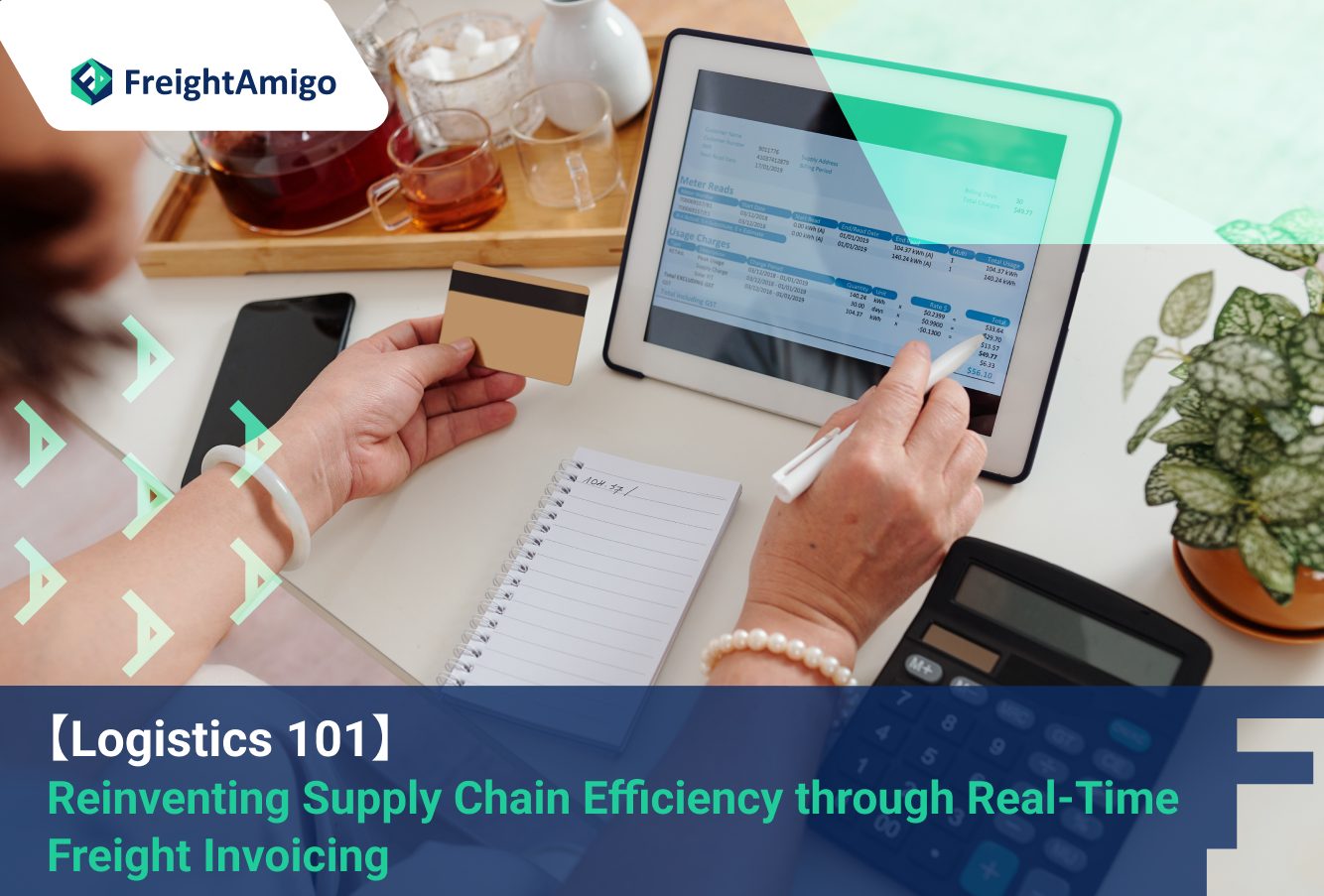Author Name: Tiffany Lee – Marketing Analyst at FreightAmigo
Supply chain management is continually evolving, with businesses seeking innovative strategies to streamline operations, minimize costs, and increase efficiency. A key component in this process is the real-time freight invoicing system. Through its implementation, businesses can revolutionize their freight management process, leading to considerable operational benefits and improved customer relationships.
Want To Compare The Best Express, Air Freight, Sea Freight, Rail Freight & Trucking Rates So As To Have Better Control On Cost?
The Drawbacks of Traditional Freight Invoicing
Traditional freight invoicing is a labor-intensive, time-consuming process. It typically involves manual data entry, physical paperwork, and communication between multiple stakeholders. This not only hampers operational efficiency but also increases the likelihood of errors and inaccuracies. Consequently, businesses face increased costs, delayed payments, and strained relationships with carriers and suppliers.
Time-Consuming Nature of Manual Invoicing
Manual freight invoice processing can consume a significant portion of a staff member’s working hours. Estimates suggest that manual processing accounts for 2 to 4 hours per day of a staff member’s time, equating to almost half of their working hours. This is both inefficient and costly, taking valuable time away from more strategic tasks like analyzing data and making informed decisions.
Inefficiencies and Errors
The traditional invoicing process is prone to inaccuracies due to the reliance on manual data entry. This can lead to incorrect billing, payment disputes, and revenue discrepancies. Furthermore, manual processes can result in lost or misplaced invoices, further delaying the payment process and potentially leading to financial losses.
The Power of Automation in Freight Invoicing
Automating the freight invoicing process can significantly enhance operational efficiency and accuracy. This innovative approach can streamline the invoicing process, reduce manual labor, and facilitate faster payment processes. It also allows for real-time tracking of invoices, facilitating better cash flow management and improved supplier relationships.
Automated Data Extraction and Entry
One of the key features of an automated freight invoicing system is the ability to extract relevant invoice information automatically. Through the use of machine learning and artificial intelligence, data can be automatically extracted from invoices and entered into the system. This eliminates the need for manual data entry, reduces the risk of errors, and significantly speeds up the invoice processing timeline.
Enhanced Invoice Verification and Audit
Automated invoicing systems can effectively verify and audit freight invoices against pre-established benchmarks and contract terms. These systems can detect discrepancies and flag potential billing errors, such as overcharges, duplicate invoices, or incorrect rates. This level of accuracy ensures that businesses pay only for the services they receive, leading to cost savings and increased supplier accountability.
The Role of Advanced Technologies in Freight Invoicing
In the age of digital transformation, advanced technologies play a pivotal role in modernizing freight invoicing. Technologies such as data analytics, machine learning, artificial intelligence, and the internet of things (IoT) are driving operational efficiency and improving supply chain visibility.
Data Analytics
Data analytics play a crucial role in optimizing supply chain processes. By analyzing historical shipping data and market trends, businesses can make informed decisions about carrier selection, demand forecasts, and inventory management. This data-driven approach can significantly enhance the efficiency and profitability of supply chain operations.
Machine Learning and AI
Machine learning and AI are revolutionizing the way freight invoices are processed. These technologies can automate data extraction and entry, invoice verification and auditing, and even predictive analytics for anticipating future trends and demands. By harnessing the power of AI and machine learning, businesses can significantly reduce manual labor, improve accuracy, and streamline their freight invoicing processes.
Internet of Things (IoT)
IoT devices provide real-time tracking and monitoring of shipments, enhancing visibility throughout the supply chain. This real-time visibility enables proactive decision-making, allowing for more efficient resource allocation and swift response to potential disruptions.
Key Factors to Consider When Implementing Real-Time Freight Invoicing
Implementing a real-time freight invoicing system requires careful planning and consideration. Businesses should consider factors such as ease of use, customization, scalability, security, and cost-effectiveness when selecting an automated freight invoicing solution.
Ease of Implementation
The chosen solution should be easy to implement with minimal disruption to existing operations. It should also offer seamless integration with existing systems and software to ensure smooth operations and data consistency.
Scalability and Customization
The system should be scalable to accommodate growing business needs and fluctuating transaction volumes. It should also offer customization options to cater to specific business requirements and preferences.
Security and Compliance
Given the sensitive nature of invoicing data, the system should provide robust security measures to safeguard against potential data breaches. It should also ensure compliance with industry regulations and standards to maintain the integrity of financial transactions.
Overcoming Challenges in Implementing Automated Freight Invoicing
Despite the numerous advantages of automated freight invoicing, businesses may encounter challenges during the implementation phase. These may include issues regarding data quality, resistance from employees accustomed to traditional methods, and integration with existing systems. However, with strategic planning and execution, these challenges can be effectively managed.
Ensuring Data Quality
Data quality is crucial to the success of an automated freight invoicing system. Businesses must ensure that the data entered into the system is accurate and up-to-date. Regular data audits can help maintain data quality and ensure the accuracy of invoicing.
Employee Training and Communication
Implementing a new system may require employee training to ensure proper usage and understanding. Communication is key to overcoming resistance and fostering acceptance of the new system. Businesses should provide clear explanations of the benefits of automation and offer ongoing support to help employees adapt to the new system.
System Integration
Integration with existing systems is critical for seamless operations. Businesses should work with a vendor that specializes in integration or use middleware to connect systems. This will ensure that all systems work together to provide a comprehensive and efficient freight invoicing solution.
Case Study: Successful Implementation of Real-Time Freight Invoicing
Successful implementation of real-time freight invoicing can significantly improve operational efficiency, reduce costs, and enhance customer satisfaction. For instance, AB InBev, one of the world’s largest brewers, implemented an automated freight invoicing system in partnership with a technology provider. The system streamlined AB InBev’s invoicing processes, improved relationships with its carriers and freight forwarders, and led to increased efficiency and cost savings.
Future Trends in Automated Freight Invoicing
As technology continues to advance, the future of automated freight invoicing looks promising. Innovations such as blockchain technology and artificial intelligence offer improved visibility, security, and compliance. Additionally, the use of predictive analytics and big data can further optimize supply chain processes and improve forecasting. As businesses continue to prioritize efficiency and cost-effectiveness, the adoption and implementation of new technologies for real-time freight invoicing will remain a critical focus in the years to come.
In conclusion, real-time freight invoicing presents a promising solution for businesses looking to enhance operational efficiency, reduce costs, and improve customer satisfaction. By leveraging advanced technologies and implementing automated solutions, businesses can revolutionize their freight management processes and gain a competitive edge in the supply chain industry.
There Are Different Options For Cargo Transportation. If You Want To Choose The Most Convenient And Suitable Solution, It Is Best To Have The Full Support Of Logistics Experts! If You Are Planning To Ship Goods Overseas, Please Go To The FreightAmigo Page For Inquiries.
===
Read More:
【Cosmetic Product Recycling】 A Guide to Sustainable Reverse Logistics
【Rise of Green Supply Chain】 Pioneering Sustainable Practices in Logistics
【ESG in Logistics】 How ESG Practices Drive Social Responsibility in Logistics
===
If you have any inquiries on logistics/supply chain, feel free to contact FreightAmigo now:
Chat with us online OR
Phone : +852 28121686
WhatsApp: +852 27467829









































